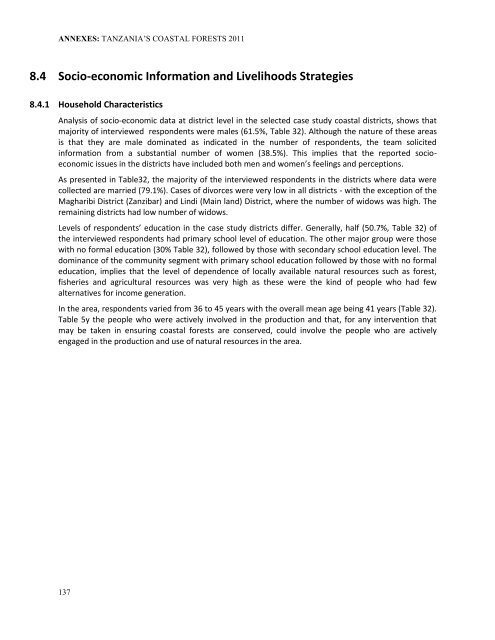Neil D. Burgess, Paul Harrison, Peter Sumbi, James Laizer, Adam ...
Neil D. Burgess, Paul Harrison, Peter Sumbi, James Laizer, Adam ...
Neil D. Burgess, Paul Harrison, Peter Sumbi, James Laizer, Adam ...
You also want an ePaper? Increase the reach of your titles
YUMPU automatically turns print PDFs into web optimized ePapers that Google loves.
ANNEXES: TANZANIA’S COASTAL FORESTS 2011<br />
8.4 Socio-economic Information and Livelihoods Strategies<br />
8.4.1 Household Characteristics<br />
Analysis of socio-economic data at district level in the selected case study coastal districts, shows that<br />
majority of interviewed respondents were males (61.5%, Table 32). Although the nature of these areas<br />
is that they are male dominated as indicated in the number of respondents, the team solicited<br />
information from a substantial number of women (38.5%). This implies that the reported socioeconomic<br />
issues in the districts have included both men and women’s feelings and perceptions.<br />
As presented in Table32, the majority of the interviewed respondents in the districts where data were<br />
collected are married (79.1%). Cases of divorces were very low in all districts - with the exception of the<br />
Magharibi District (Zanzibar) and Lindi (Main land) District, where the number of widows was high. The<br />
remaining districts had low number of widows.<br />
Levels of respondents’ education in the case study districts differ. Generally, half (50.7%, Table 32) of<br />
the interviewed respondents had primary school level of education. The other major group were those<br />
with no formal education (30% Table 32), followed by those with secondary school education level. The<br />
dominance of the community segment with primary school education followed by those with no formal<br />
education, implies that the level of dependence of locally available natural resources such as forest,<br />
fisheries and agricultural resources was very high as these were the kind of people who had few<br />
alternatives for income generation.<br />
In the area, respondents varied from 36 to 45 years with the overall mean age being 41 years (Table 32).<br />
Table 5y the people who were actively involved in the production and that, for any intervention that<br />
may be taken in ensuring coastal forests are conserved, could involve the people who are actively<br />
engaged in the production and use of natural resources in the area.<br />
137

















